Introduccion
Hola Habr Hoy quiero hablar un poco sobre cómo puede comenzar rápida y sin dolor (casi) a comenzar a escribir sombreadores de
texto clásicos en Unity utilizando la
canalización de representación ligera (LWRP) , uno de los ejemplos de la
canalización de representación programable (SRP) .
¿Pero qué pasa con el Shader Graph?
Shader Graph es una herramienta conveniente y rápida para crear prototipos o escribir efectos simples. Sin embargo, a veces, es necesario escribir algo complicado y complejo, y luego, el número de nodos, funciones personalizadas, sub-gráficos aumenta increíblemente, por lo que incluso el programador gráfico más experimentado comienza a confundirse en todo este lío. Todos entendemos que el código generado automáticamente a priori no puede ser mejor que el escrito manualmente; no necesita ir muy lejos para obtener ejemplos, porque cualquier error en el diseño de los nodos puede llevar al hecho de que el resultado de cálculo ya conocido en el sombreador de vértices se contará repetidamente en el fragmento. Hay personas que se sienten más cómodas trabajando con
código que con nodos. Las razones pueden ser diferentes, pero la esencia es la misma: ¡abajo con los nodos, viva el código!
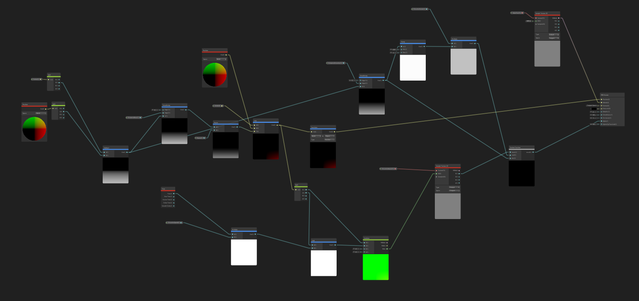
Problema
Entonces, ¿cuál es el problema de sentarse y escribir un sombreador de texto normal bajo LWRP? Y el problema es que los sombreadores de
superficie estándar favoritos de todos no son compatibles con LWRP.
Cuando intentamos usarlo, obtenemos lo siguiente:
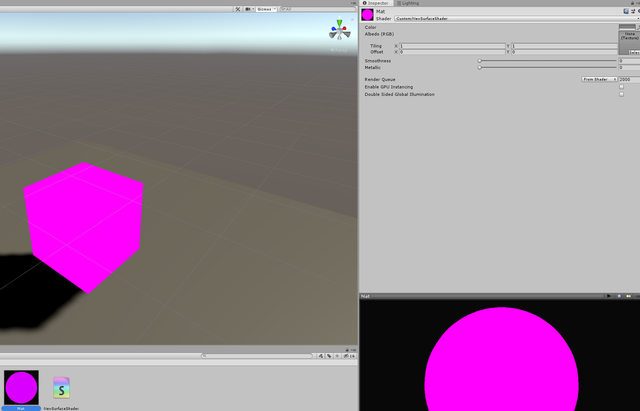
Código de sombreadorShader "Custom/NewSurfaceShader" { Properties { _Color ("Color", Color) = (1,1,1,1) _MainTex ("Albedo (RGB)", 2D) = "white" {} _Glossiness ("Smoothness", Range(0,1)) = 0.5 _Metallic ("Metallic", Range(0,1)) = 0.0 } SubShader { Tags { "RenderType"="Opaque" } LOD 200 CGPROGRAM
Entonces se me ocurre intentar escribir un sombreador de anlita normal con una parte de vértice y fragmento. Y afortunadamente, todo funciona:

Código de sombreador Shader "Unlit/NewUnlitShader" { Properties { _MainTex ("Texture", 2D) = "white" {} } SubShader { Tags { "RenderType"="Opaque" } LOD 100 Pass { CGPROGRAM #pragma vertex vert #pragma fragment frag
Sin embargo, ¿cómo puedes no estar triste? Parecía que nos dejaran desnudos al margen sin luz, sombras, mapas de luz y queridos
PBR , sin los cuales la vida no era dulce.
Por supuesto, puedes escribir todo a mano:
¡Que haya luz!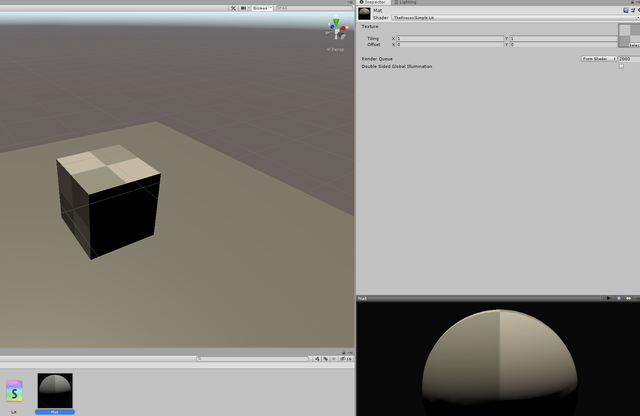
Código de sombreador Shader "TheProxor/Simple Lit" { Properties { _MainTex("Texture", 2D) = "white" {} } SubShader { Tags { "RenderType" = "Opaque" } LOD 100 Pass { CGPROGRAM #pragma vertex vert #pragma fragment frag
Todo parece funcionar, pero esta es solo una iluminación difusa. ¿Qué hacer a continuación? Puede continuar devolviendo todo a mano, pero es largo y triste, y no se puede devolver PBR de ninguna manera, y perdemos todos los chips LWRP. Por lo tanto, no tenemos más remedio que elegir LWRP para devolver todo con un golpe mágico.
Solución
Entonces, como saben, LWRP se construye sobre la base del
renderizador Forward , lo que significa que tiene su propio LitForwardPass, que debería describirse en alguna parte. Obviamente, en algún lugar hay un CGInclude en el que se describe todo esto. Aquí es donde comenzamos una divertida aventura en:
% localappdata% \ Unity \ cache \ packages \ packages.unity.com \ com.unity.render-pipelines.lightweight @ (versión LWRP) \
En realidad, después de llegar a la dirección especificada y entrar en la carpeta
Shaders , podemos encontrar un sombreador interesante llamado
Lit.shader . En realidad, podemos decir que nuestra búsqueda ha terminado, aquí está: el codiciado sombreador. Al entrar, encontramos los siguientes contenidos:
Sombreador iluminado Shader "Lightweight Render Pipeline/Lit" { Properties {
Solo queda expandirlo para facilitar la edición, deshacerse de las inclusiones. Bueno, un poco de modificación a tu manera.
Obtenemos algo como esto:
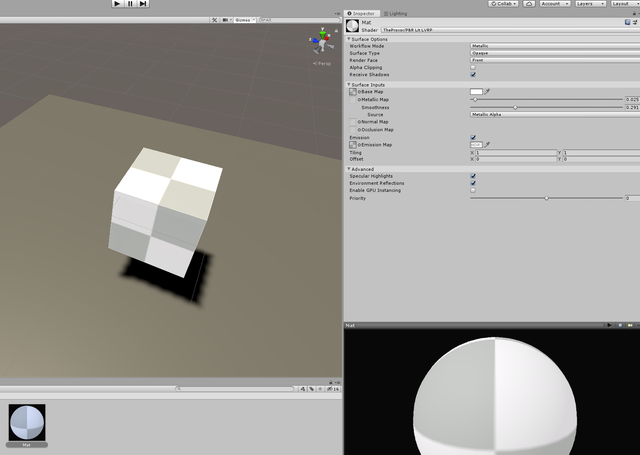
Final uber shader Shader "TheProxor/LWRP/Dissolve + Vertex Offset" { Properties {
En primer lugar, debe distinguir qué es qué en el sombreador resultante. En primer lugar, estamos interesados en la línea:
CustomEditor "UnityEditor.Rendering.LWRP.ShaderGUI.LitShaderEditor"
Que, como recordamos, en el original era el siguiente:
CustomEditor "UnityEditor.Rendering.LWRP.ShaderGUI.LitShader"
Entonces, ¿qué es y por qué? La respuesta a esta pregunta es bastante simple: si observa de cerca, el sombreador tiene una gran cantidad de diferentes tipos de definiciones, que, curiosamente, deben activarse y desactivarse, y esto, por un momento, debe hacerse desde el código, por lo que necesitamos un inspector personalizado. Además, nuestro inspector personalizado debería darnos la oportunidad de editar no solo las propiedades integradas, sino también aquellas que podamos necesitar en nuestros sombreadores. , :
%localappdata%\Unity\cache\packages\packages.unity.com\com.unity.render-pipelines.lightweight@6.9.2\Editor\ShaderGUI\Shaders\
, LitShader.cs, BaseShaderGUI:
internal class LitShader : BaseShaderGUI { ... }
BaseShaderGUI.cs, :
public abstract class BaseShaderGUI : ShaderGUI { ... }
Editor ( — , , UnityEditor ). , , -
SavedBool , bool. . , .
:
SavedBool m_SurfaceOptionsFoldout; SavedBool m_SurfaceInputsFoldout; SavedBool m_AdvancedFoldout;
:
AnimatedValues.AnimBool m_SurfaceOptionsFoldout; AnimatedValues.AnimBool m_SurfaceInputsFoldout; AnimatedValues.AnimBool m_AdvancedFoldout;
:
AnimatedValues.AnimBool m_OtherFoldout;
, :
protected class Styles {
. ,
HideInInspector , , . , , ? , ! , -. :
... [MainColor][HideInInspector] _BaseColor("Color", Color) = (0.5,0.5,0.5,1) [MainTexture][HideInInspector] _BaseMap("Albedo", 2D) = "white" {} [HideInInspector]_Cutoff("Alpha Cutoff", Range(0.0, 1.0)) = 0.5 [HideInInspector]_Smoothness("Smoothness", Range(0.0, 1.0)) = 0.5 [HideInInspector]_GlossMapScale("Smoothness Scale", Range(0.0, 1.0)) = 1.0 [HideInInspector]_SmoothnessTextureChannel("Smoothness texture channel", Float) = 0 ...
:
public override void OnGUI(...) { ... m_OtherFoldout.value = EditorGUILayout.BeginFoldoutHeaderGroup(m_OtherFoldout.value, Styles.OtherOptions); if (m_OtherFoldout.value) { base.OnGUI(materialEditorIn, properties); EditorGUILayout.Space(); } EditorGUILayout.EndFoldoutHeaderGroup(); ... }
:
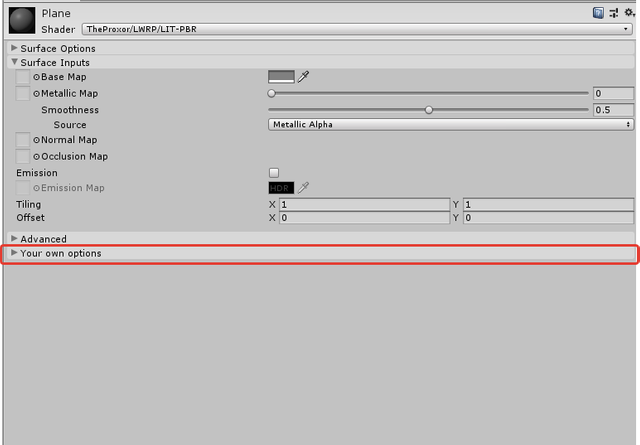
:
BaseShaderEditor.cs using System; using UnityEngine; using UnityEngine.Rendering; using UnityEditor.Rendering; namespace UnityEditor { public abstract class BaseShaderEditor : ShaderGUI { #region EnumsAndClasses public enum SurfaceType { Opaque, Transparent } public enum BlendMode { Alpha, // Old school alpha-blending mode, fresnel does not affect amount of transparency Premultiply, // Physically plausible transparency mode, implemented as alpha pre-multiply Additive, Multiply } public enum SmoothnessSource { BaseAlpha, SpecularAlpha } public enum RenderFace { Front = 2, Back = 1, Both = 0 } protected class Styles { // Catergories public static readonly GUIContent SurfaceOptions = new GUIContent("Surface Options", "Controls how LWRP renders the Material on a screen."); public static readonly GUIContent SurfaceInputs = new GUIContent("Surface Inputs", "These settings describe the look and feel of the surface itself."); public static readonly GUIContent AdvancedLabel = new GUIContent("Advanced", "These settings affect behind-the-scenes rendering and underlying calculations."); public static readonly GUIContent surfaceType = new GUIContent("Surface Type", "Select a surface type for your texture. Choose between Opaque or Transparent."); public static readonly GUIContent blendingMode = new GUIContent("Blending Mode", "Controls how the color of the Transparent surface blends with the Material color in the background."); public static readonly GUIContent cullingText = new GUIContent("Render Face", "Specifies which faces to cull from your geometry. Front culls front faces. Back culls backfaces. None means that both sides are rendered."); public static readonly GUIContent alphaClipText = new GUIContent("Alpha Clipping", "Makes your Material act like a Cutout shader. Use this to create a transparent effect with hard edges between opaque and transparent areas."); public static readonly GUIContent alphaClipThresholdText = new GUIContent("Threshold", "Sets where the Alpha Clipping starts. The higher the value is, the brighter the effect is when clipping starts."); public static readonly GUIContent receiveShadowText = new GUIContent("Receive Shadows", "When enabled, other GameObjects can cast shadows onto this GameObject."); public static readonly GUIContent baseMap = new GUIContent("Base Map", "Specifies the base Material and/or Color of the surface. If you've selected Transparent or Alpha Clipping under Surface Options, your Material uses the Texture's alpha channel or color."); public static readonly GUIContent emissionMap = new GUIContent("Emission Map", "Sets a Texture map to use for emission. You can also select a color with the color picker. Colors are multiplied over the Texture."); public static readonly GUIContent normalMapText = new GUIContent("Normal Map", "Assigns a tangent-space normal map."); public static readonly GUIContent bumpScaleNotSupported = new GUIContent("Bump scale is not supported on mobile platforms"); public static readonly GUIContent fixNormalNow = new GUIContent("Fix now", "Converts the assigned texture to be a normal map format."); public static readonly GUIContent queueSlider = new GUIContent("Priority", "Determines the chronological rendering order for a Material. High values are rendered first."); public static readonly GUIContent OtherOptions = new GUIContent("Your own options", "You own custom options"); } #endregion #region Variables protected MaterialEditor materialEditor { get; set; } protected MaterialProperty surfaceTypeProp { get; set; } protected MaterialProperty blendModeProp { get; set; } protected MaterialProperty cullingProp { get; set; } protected MaterialProperty alphaClipProp { get; set; } protected MaterialProperty alphaCutoffProp { get; set; } protected MaterialProperty receiveShadowsProp { get; set; } // Common Surface Input properties protected MaterialProperty baseMapProp { get; set; } protected MaterialProperty baseColorProp { get; set; } protected MaterialProperty emissionMapProp { get; set; } protected MaterialProperty emissionColorProp { get; set; } protected MaterialProperty queueOffsetProp { get; set; } public bool m_FirstTimeApply = true; private const string k_KeyPrefix = "LightweightRP:Material:UI_State:"; private string m_HeaderStateKey = null; // Header foldout states AnimatedValues.AnimBool m_SurfaceOptionsFoldout; AnimatedValues.AnimBool m_SurfaceInputsFoldout; AnimatedValues.AnimBool m_AdvancedFoldout; AnimatedValues.AnimBool m_OtherFoldout; #endregion private const int queueOffsetRange = 50; //////////////////////////////////// // General Functions // //////////////////////////////////// #region GeneralFunctions public abstract void MaterialChanged(Material material); public virtual void FindProperties(MaterialProperty[] properties) { surfaceTypeProp = FindProperty("_Surface", properties); blendModeProp = FindProperty("_Blend", properties); cullingProp = FindProperty("_Cull", properties); alphaClipProp = FindProperty("_AlphaClip", properties); alphaCutoffProp = FindProperty("_Cutoff", properties); receiveShadowsProp = FindProperty("_ReceiveShadows", properties, false); baseMapProp = FindProperty("_BaseMap", properties, false); baseColorProp = FindProperty("_BaseColor", properties, false); emissionMapProp = FindProperty("_EmissionMap", properties, false); emissionColorProp = FindProperty("_EmissionColor", properties, false); queueOffsetProp = FindProperty("_QueueOffset", properties, false); } public override void OnGUI(MaterialEditor materialEditorIn, MaterialProperty[] properties) { if (materialEditorIn == null) throw new ArgumentNullException("materialEditorIn"); FindProperties(properties); // MaterialProperties can be animated so we do not cache them but fetch them every event to ensure animated values are updated correctly materialEditor = materialEditorIn; Material material = materialEditor.target as Material; // Make sure that needed setup (ie keywords/renderqueue) are set up if we're switching some existing // material to a lightweight shader. if (m_FirstTimeApply) { OnOpenGUI(material, materialEditorIn); m_FirstTimeApply = false; } ShaderPropertiesGUI(material); m_OtherFoldout.value = EditorGUILayout.BeginFoldoutHeaderGroup(m_OtherFoldout.value, Styles.OtherOptions); if (m_OtherFoldout.value) { base.OnGUI(materialEditorIn, properties); EditorGUILayout.Space(); } EditorGUILayout.EndFoldoutHeaderGroup(); foreach (var obj in materialEditor.targets) MaterialChanged((Material)obj); } public virtual void OnOpenGUI(Material material, MaterialEditor materialEditor) { // Foldout states m_HeaderStateKey = k_KeyPrefix + material.shader.name; // Create key string for editor prefs m_SurfaceOptionsFoldout = new AnimatedValues.AnimBool(true); m_SurfaceInputsFoldout = new AnimatedValues.AnimBool(true); m_AdvancedFoldout = new AnimatedValues.AnimBool(true); m_OtherFoldout = new AnimatedValues.AnimBool(true); foreach (var obj in materialEditor.targets) MaterialChanged((Material)obj); } public void ShaderPropertiesGUI(Material material) { if (material == null) throw new ArgumentNullException("material"); EditorGUI.BeginChangeCheck(); m_SurfaceOptionsFoldout.value = EditorGUILayout.BeginFoldoutHeaderGroup(m_SurfaceOptionsFoldout.value, Styles.SurfaceOptions); if (m_SurfaceOptionsFoldout.value) { DrawSurfaceOptions(material); EditorGUILayout.Space(); } EditorGUILayout.EndFoldoutHeaderGroup(); m_SurfaceInputsFoldout.value = EditorGUILayout.BeginFoldoutHeaderGroup(m_SurfaceInputsFoldout.value, Styles.SurfaceInputs); if (m_SurfaceInputsFoldout.value) { DrawSurfaceInputs(material); EditorGUILayout.Space(); } EditorGUILayout.EndFoldoutHeaderGroup(); m_AdvancedFoldout.value = EditorGUILayout.BeginFoldoutHeaderGroup(m_AdvancedFoldout.value, Styles.AdvancedLabel); if (m_AdvancedFoldout.value) { DrawAdvancedOptions(material); EditorGUILayout.Space(); } EditorGUILayout.EndFoldoutHeaderGroup(); DrawAdditionalFoldouts(material); if (EditorGUI.EndChangeCheck()) { foreach (var obj in materialEditor.targets) MaterialChanged((Material)obj); } } #endregion //////////////////////////////////// // Drawing Functions // //////////////////////////////////// #region DrawingFunctions public virtual void DrawSurfaceOptions(Material material) { DoPopup(Styles.surfaceType, surfaceTypeProp, Enum.GetNames(typeof(SurfaceType))); if ((SurfaceType)material.GetFloat("_Surface") == SurfaceType.Transparent) DoPopup(Styles.blendingMode, blendModeProp, Enum.GetNames(typeof(BlendMode))); EditorGUI.BeginChangeCheck(); EditorGUI.showMixedValue = cullingProp.hasMixedValue; var culling = (RenderFace)cullingProp.floatValue; culling = (RenderFace)EditorGUILayout.EnumPopup(Styles.cullingText, culling); if (EditorGUI.EndChangeCheck()) { materialEditor.RegisterPropertyChangeUndo(Styles.cullingText.text); cullingProp.floatValue = (float)culling; material.doubleSidedGI = (RenderFace)cullingProp.floatValue != RenderFace.Front; } EditorGUI.showMixedValue = false; EditorGUI.BeginChangeCheck(); EditorGUI.showMixedValue = alphaClipProp.hasMixedValue; var alphaClipEnabled = EditorGUILayout.Toggle(Styles.alphaClipText, alphaClipProp.floatValue == 1); if (EditorGUI.EndChangeCheck()) alphaClipProp.floatValue = alphaClipEnabled ? 1 : 0; EditorGUI.showMixedValue = false; if (alphaClipProp.floatValue == 1) materialEditor.ShaderProperty(alphaCutoffProp, Styles.alphaClipThresholdText, 1); if (receiveShadowsProp != null) { EditorGUI.BeginChangeCheck(); EditorGUI.showMixedValue = receiveShadowsProp.hasMixedValue; var receiveShadows = EditorGUILayout.Toggle(Styles.receiveShadowText, receiveShadowsProp.floatValue == 1.0f); if (EditorGUI.EndChangeCheck()) receiveShadowsProp.floatValue = receiveShadows ? 1.0f : 0.0f; EditorGUI.showMixedValue = false; } } public virtual void DrawSurfaceInputs(Material material) { DrawBaseProperties(material); } public virtual void DrawAdvancedOptions(Material material) { materialEditor.EnableInstancingField(); if (queueOffsetProp != null) { EditorGUI.BeginChangeCheck(); EditorGUI.showMixedValue = queueOffsetProp.hasMixedValue; var queue = EditorGUILayout.IntSlider(Styles.queueSlider, (int)queueOffsetProp.floatValue, -queueOffsetRange, queueOffsetRange); if (EditorGUI.EndChangeCheck()) queueOffsetProp.floatValue = queue; EditorGUI.showMixedValue = false; } } public virtual void DrawAdditionalFoldouts(Material material) { } public virtual void DrawBaseProperties(Material material) { if (baseMapProp != null && baseColorProp != null) // Draw the baseMap, most shader will have at least a baseMap { materialEditor.TexturePropertySingleLine(Styles.baseMap, baseMapProp, baseColorProp); // TODO Temporary fix for lightmapping, to be replaced with attribute tag. if (material.HasProperty("_MainTex")) { material.SetTexture("_MainTex", baseMapProp.textureValue); var baseMapTiling = baseMapProp.textureScaleAndOffset; material.SetTextureScale("_MainTex", new Vector2(baseMapTiling.x, baseMapTiling.y)); material.SetTextureOffset("_MainTex", new Vector2(baseMapTiling.z, baseMapTiling.w)); } } } protected virtual void DrawEmissionProperties(Material material, bool keyword) { var emissive = true; var hadEmissionTexture = emissionMapProp.textureValue != null; if (!keyword) { materialEditor.TexturePropertyWithHDRColor(Styles.emissionMap, emissionMapProp, emissionColorProp, false); } else { // Emission for GI? emissive = materialEditor.EmissionEnabledProperty(); EditorGUI.BeginDisabledGroup(!emissive); { // Texture and HDR color controls materialEditor.TexturePropertyWithHDRColor(Styles.emissionMap, emissionMapProp, emissionColorProp, false); } EditorGUI.EndDisabledGroup(); } // If texture was assigned and color was black set color to white var brightness = emissionColorProp.colorValue.maxColorComponent; if (emissionMapProp.textureValue != null && !hadEmissionTexture && brightness <= 0f) emissionColorProp.colorValue = Color.white; // LW does not support RealtimeEmissive. We set it to bake emissive and handle the emissive is black right. if (emissive) { material.globalIlluminationFlags = MaterialGlobalIlluminationFlags.BakedEmissive; if (brightness <= 0f) material.globalIlluminationFlags |= MaterialGlobalIlluminationFlags.EmissiveIsBlack; } } public static void DrawNormalArea(MaterialEditor materialEditor, MaterialProperty bumpMap, MaterialProperty bumpMapScale = null) { if (bumpMapScale != null) { materialEditor.TexturePropertySingleLine(Styles.normalMapText, bumpMap, bumpMap.textureValue != null ? bumpMapScale : null); if (bumpMapScale.floatValue != 1 && UnityEditorInternal.InternalEditorUtility.IsMobilePlatform( EditorUserBuildSettings.activeBuildTarget)) if (materialEditor.HelpBoxWithButton(Styles.bumpScaleNotSupported, Styles.fixNormalNow)) bumpMapScale.floatValue = 1; } else { materialEditor.TexturePropertySingleLine(Styles.normalMapText, bumpMap); } } protected static void DrawTileOffset(MaterialEditor materialEditor, MaterialProperty textureProp) { materialEditor.TextureScaleOffsetProperty(textureProp); } #endregion //////////////////////////////////// // Material Data Functions // //////////////////////////////////// #region MaterialDataFunctions public static void SetMaterialKeywords(Material material, Action<Material> shadingModelFunc = null, Action<Material> shaderFunc = null) { // Clear all keywords for fresh start material.shaderKeywords = null; // Setup blending - consistent across all LWRP shaders SetupMaterialBlendMode(material); // Receive Shadows if (material.HasProperty("_ReceiveShadows")) CoreUtils.SetKeyword(material, "_RECEIVE_SHADOWS_OFF", material.GetFloat("_ReceiveShadows") == 0.0f); // Emission if (material.HasProperty("_EmissionColor")) MaterialEditor.FixupEmissiveFlag(material); bool shouldEmissionBeEnabled = (material.globalIlluminationFlags & MaterialGlobalIlluminationFlags.EmissiveIsBlack) == 0; if (material.HasProperty("_EmissionEnabled") && !shouldEmissionBeEnabled) shouldEmissionBeEnabled = material.GetFloat("_EmissionEnabled") >= 0.5f; CoreUtils.SetKeyword(material, "_EMISSION", shouldEmissionBeEnabled); // Normal Map if (material.HasProperty("_BumpMap")) CoreUtils.SetKeyword(material, "_NORMALMAP", material.GetTexture("_BumpMap")); // Shader specific keyword functions shadingModelFunc?.Invoke(material); shaderFunc?.Invoke(material); } public static void SetupMaterialBlendMode(Material material) { if (material == null) throw new ArgumentNullException("material"); bool alphaClip = material.GetFloat("_AlphaClip") == 1; if (alphaClip) { material.EnableKeyword("_ALPHATEST_ON"); } else { material.DisableKeyword("_ALPHATEST_ON"); } var queueOffset = 0; // queueOffsetRange; if (material.HasProperty("_QueueOffset")) queueOffset = queueOffsetRange - (int)material.GetFloat("_QueueOffset"); SurfaceType surfaceType = (SurfaceType)material.GetFloat("_Surface"); if (surfaceType == SurfaceType.Opaque) { if (alphaClip) { material.renderQueue = (int)UnityEngine.Rendering.RenderQueue.AlphaTest; material.SetOverrideTag("RenderType", "TransparentCutout"); } else { material.renderQueue = (int)UnityEngine.Rendering.RenderQueue.Geometry; material.SetOverrideTag("RenderType", "Opaque"); } material.renderQueue += queueOffset; material.SetInt("_SrcBlend", (int)UnityEngine.Rendering.BlendMode.One); material.SetInt("_DstBlend", (int)UnityEngine.Rendering.BlendMode.Zero); material.SetInt("_ZWrite", 1); material.DisableKeyword("_ALPHAPREMULTIPLY_ON"); material.SetShaderPassEnabled("ShadowCaster", true); } else { BlendMode blendMode = (BlendMode)material.GetFloat("_Blend"); var queue = (int)UnityEngine.Rendering.RenderQueue.Transparent; // Specific Transparent Mode Settings switch (blendMode) { case BlendMode.Alpha: material.SetInt("_SrcBlend", (int)UnityEngine.Rendering.BlendMode.SrcAlpha); material.SetInt("_DstBlend", (int)UnityEngine.Rendering.BlendMode.OneMinusSrcAlpha); material.DisableKeyword("_ALPHAPREMULTIPLY_ON"); break; case BlendMode.Premultiply: material.SetInt("_SrcBlend", (int)UnityEngine.Rendering.BlendMode.One); material.SetInt("_DstBlend", (int)UnityEngine.Rendering.BlendMode.OneMinusSrcAlpha); material.EnableKeyword("_ALPHAPREMULTIPLY_ON"); break; case BlendMode.Additive: material.SetInt("_SrcBlend", (int)UnityEngine.Rendering.BlendMode.One); material.SetInt("_DstBlend", (int)UnityEngine.Rendering.BlendMode.One); material.DisableKeyword("_ALPHAPREMULTIPLY_ON"); break; case BlendMode.Multiply: material.SetInt("_SrcBlend", (int)UnityEngine.Rendering.BlendMode.DstColor); material.SetInt("_DstBlend", (int)UnityEngine.Rendering.BlendMode.Zero); material.DisableKeyword("_ALPHAPREMULTIPLY_ON"); material.EnableKeyword("_ALPHAMODULATE_ON"); break; } // General Transparent Material Settings material.SetOverrideTag("RenderType", "Transparent"); material.SetInt("_ZWrite", 0); material.renderQueue = queue + queueOffset; material.SetShaderPassEnabled("ShadowCaster", false); } } #endregion //////////////////////////////////// // Helper Functions // //////////////////////////////////// #region HelperFunctions public static void TwoFloatSingleLine(GUIContent title, MaterialProperty prop1, GUIContent prop1Label, MaterialProperty prop2, GUIContent prop2Label, MaterialEditor materialEditor, float labelWidth = 30f) { EditorGUI.BeginChangeCheck(); EditorGUI.showMixedValue = prop1.hasMixedValue || prop2.hasMixedValue; Rect rect = EditorGUILayout.GetControlRect(); EditorGUI.PrefixLabel(rect, title); var indent = EditorGUI.indentLevel; var preLabelWidth = EditorGUIUtility.labelWidth; EditorGUI.indentLevel = 0; EditorGUIUtility.labelWidth = labelWidth; Rect propRect1 = new Rect(rect.x + preLabelWidth, rect.y, (rect.width - preLabelWidth) * 0.5f, EditorGUIUtility.singleLineHeight); var prop1val = EditorGUI.FloatField(propRect1, prop1Label, prop1.floatValue); Rect propRect2 = new Rect(propRect1.x + propRect1.width, rect.y, propRect1.width, EditorGUIUtility.singleLineHeight); var prop2val = EditorGUI.FloatField(propRect2, prop2Label, prop2.floatValue); EditorGUI.indentLevel = indent; EditorGUIUtility.labelWidth = preLabelWidth; if (EditorGUI.EndChangeCheck()) { materialEditor.RegisterPropertyChangeUndo(title.text); prop1.floatValue = prop1val; prop2.floatValue = prop2val; } EditorGUI.showMixedValue = false; } public void DoPopup(GUIContent label, MaterialProperty property, string[] options) { DoPopup(label, property, options, materialEditor); } public static void DoPopup(GUIContent label, MaterialProperty property, string[] options, MaterialEditor materialEditor) { if (property == null) throw new ArgumentNullException("property"); EditorGUI.showMixedValue = property.hasMixedValue; var mode = property.floatValue; EditorGUI.BeginChangeCheck(); mode = EditorGUILayout.Popup(label, (int)mode, options); if (EditorGUI.EndChangeCheck()) { materialEditor.RegisterPropertyChangeUndo(label.text); property.floatValue = mode; } EditorGUI.showMixedValue = false; } // Helper to show texture and color properties public static Rect TextureColorProps(MaterialEditor materialEditor, GUIContent label, MaterialProperty textureProp, MaterialProperty colorProp, bool hdr = false) { Rect rect = EditorGUILayout.GetControlRect(); EditorGUI.showMixedValue = textureProp.hasMixedValue; materialEditor.TexturePropertyMiniThumbnail(rect, textureProp, label.text, label.tooltip); EditorGUI.showMixedValue = false; if (colorProp != null) { EditorGUI.BeginChangeCheck(); EditorGUI.showMixedValue = colorProp.hasMixedValue; int indentLevel = EditorGUI.indentLevel; EditorGUI.indentLevel = 0; Rect rectAfterLabel = new Rect(rect.x + EditorGUIUtility.labelWidth, rect.y, EditorGUIUtility.fieldWidth, EditorGUIUtility.singleLineHeight); var col = EditorGUI.ColorField(rectAfterLabel, GUIContent.none, colorProp.colorValue, true, false, hdr); EditorGUI.indentLevel = indentLevel; if (EditorGUI.EndChangeCheck()) { materialEditor.RegisterPropertyChangeUndo(colorProp.displayName); colorProp.colorValue = col; } EditorGUI.showMixedValue = false; } return rect; } // Copied from shaderGUI as it is a protected function in an abstract class, unavailable to others public new static MaterialProperty FindProperty(string propertyName, MaterialProperty[] properties) { return FindProperty(propertyName, properties, true); } // Copied from shaderGUI as it is a protected function in an abstract class, unavailable to others public new static MaterialProperty FindProperty(string propertyName, MaterialProperty[] properties, bool propertyIsMandatory) { for (int index = 0; index < properties.Length; ++index) { if (properties[index] != null && properties[index].name == propertyName) return properties[index]; } if (propertyIsMandatory) throw new ArgumentException("Could not find MaterialProperty: '" + propertyName + "', Num properties: " + (object)properties.Length); return null; } #endregion } }
LitShaderEditor.cs using System; using UnityEngine; using UnityEngine.Rendering; using UnityEditor.Rendering.LWRP; namespace UnityEditor.Rendering.LWRP.ShaderGUI { internal class LitShaderEditor : BaseShaderEditor {
.
— , . :
- ForwardLit: Pase hacia adelante, aquí consideramos la luz, PBR y niebla.
- ShadowCaster: aquí está el cálculo de las sombras.
- DepthOnly: Depth (Z-Buffer).
- Meta: luz al horno (mapas de luz).
- Lightweight2D: sprites y UI.
Además, Unity tiene varios compiladores de sombreadores diferentes y compiladores cruzados. SRP requiere HLSLcc. En las plataformas que usan la API de gráficos OpenGL ES (como Android), HLSLcc no se usa de manera predeterminada.Por lo tanto, lo obligamos a conectar: #pragma prefer_hlslcc gles
Pero DirectX 9 no es compatible, así que desactívelo por la fuerza: #pragma exclude_renderers d3d11_9x
— , CG, HLSL, :
HLSLPROGRAM ... ENDHLSL
-
_Time ,
_ScreenParams _WorldSpaceCameraPos . ,
UnityCG.cginc . , ,
UnityObjectToClipPos(POSITION) TransformWorldToHClip(POSITION) , —
UNITY_APPLY_FOG(fogCoord, color) MixFog(color, fogCoord) .
, Core.hlsl:
%localappdata%\Unity\cache\packages\packages.unity.com\com.unity.render-pipelines.lightweight@( LWRP)\ShaderLibrary\Core.hlsl
.
(CBUFFER) UnityPerMaterial. , GPU, .
CBUFFER_START CBUFFER_END :
CBUFFER_START(UnityPerMaterial) float4 _BaseMap_ST; half4 _BaseColor; half4 _SpecColor; half4 _EmissionColor; half _Cutoff; half _Smoothness; half _Metallic; half _BumpScale; half _OcclusionStrength; CBUFFER_END
- ( , ) - .
LWRP —
UnityPerObject UnityPerMaterial . , . , , setpass . , , LWRP .
, — , .
, , ,
.
, SurfaceData:
SurfaceData surfaceData;
, -
PBR Master ShaderGraph .
Ejemplo
, ,
! -
Vertex Displacement Dissolve Effect , .
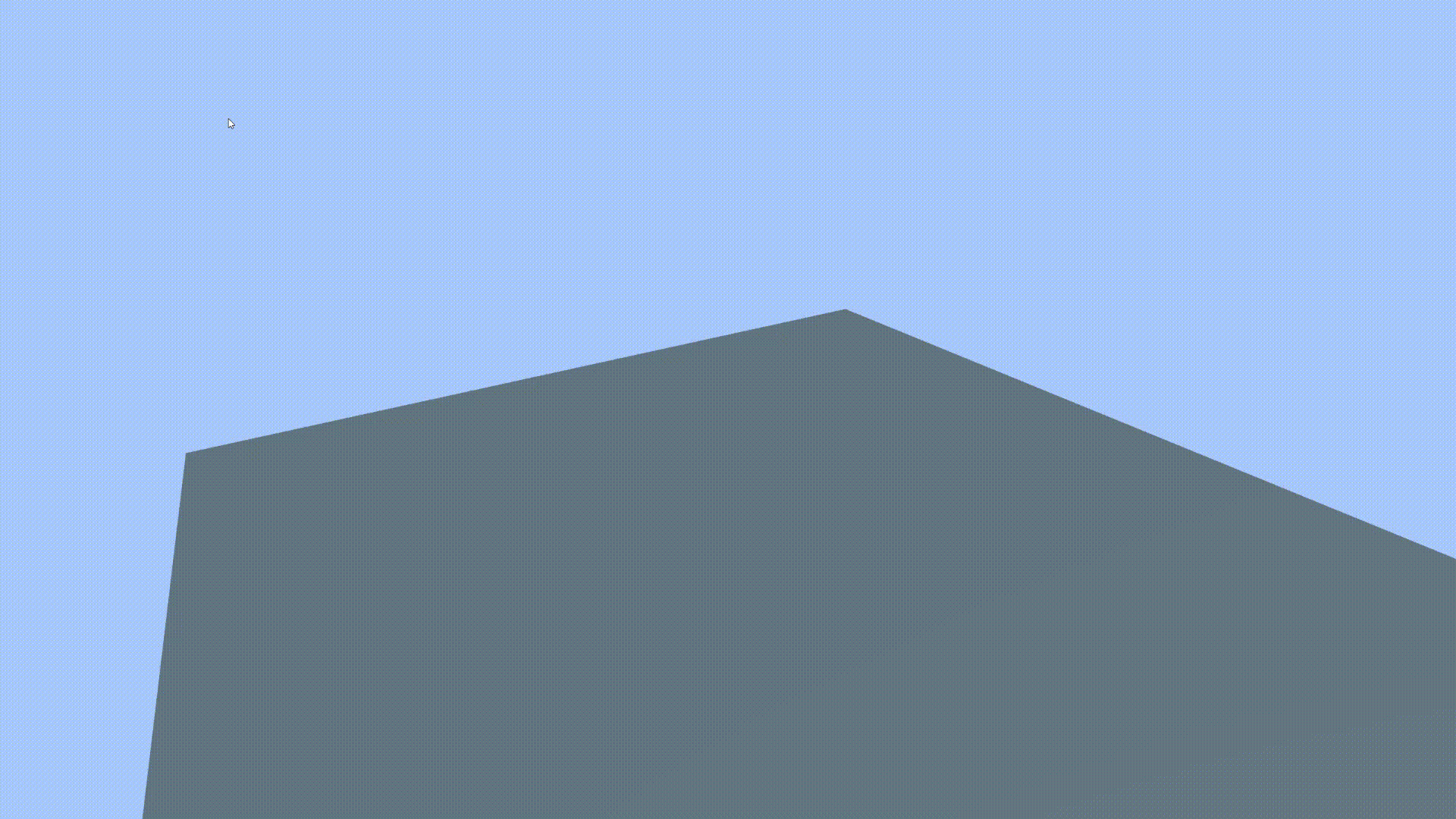
, .
:
Properties { ... _DissolveMap("Dissolve Map", 2D) = "white" {} _DissolveFactor("Dissolve Factor", Range(0, 1)) = 0.0 _DissolveWidth("Dissolve Width", Range(0, 1)) = 0.0 [HDR]_DissolveColor("Color", Color) = (1,1,0) }
:
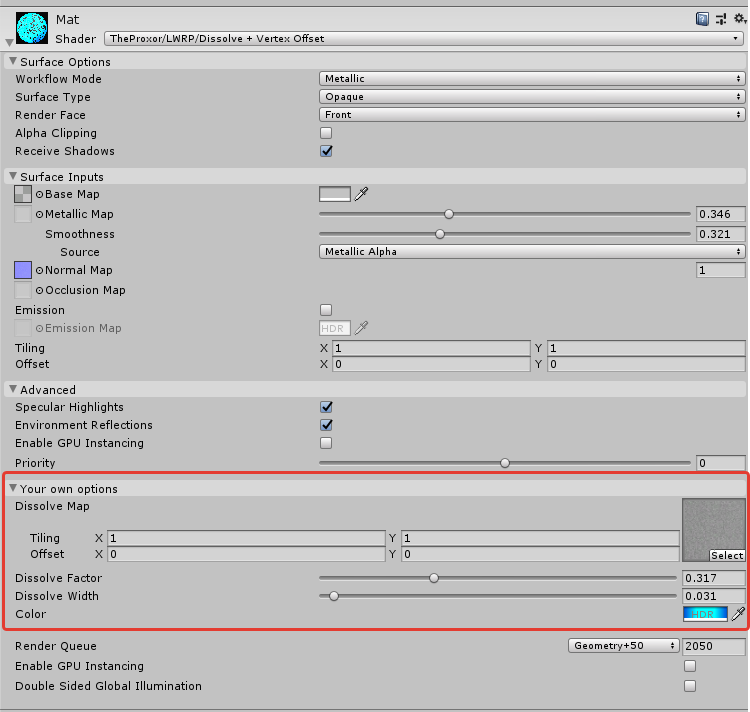
:
CBUFFER_START(UnityPerMaterial) ... float4 _DissolveMap_ST;
:
Varyings LitPassVertex(Attributes input) { ... input.positionOS.xyz += normalize(input.positionOS.xyz) * sin(input.positionOS.x) * sin(_Time.x * 100); ... }
:
Varyings ShadowPassVertex(Attributes input) { ... input.positionOS.xyz += normalize(input.positionOS.xyz) * sin(input.positionOS.x) * sin(_Time.x * 100); ... }
:
Varyings DepthOnlyVertex(Attributes input) { ... input.position.xyz += normalize(input.position.xyz) * sin(input.position.x) * sin(_Time.x * 100); ... }
Dissolve :
half4 LitPassFragment(Varyings input) : SV_Target { ...
Dissolve , ,
Shader Graph , — .
half4 ShadowPassFragment(Varyings input) : SV_TARGET { ... float4 mask = SAMPLE_TEXTURE2D(_DissolveMap, sampler_DissolveMap, input.uv); if (mask.r > _DissolveFactor) discard; ... }
:
SimpleDissolve Shader "TheProxor/LWRP/Dissolve + Vertex Offset" { Properties {
Conclusión
, . , LWRP , , , , . ,
Standard Surface Shader- , - LWRP HDRP, - .
:
,LWRP